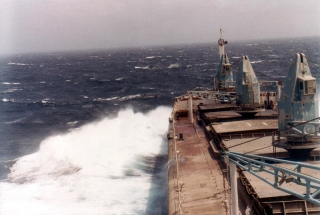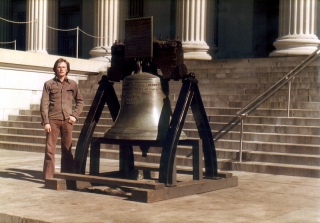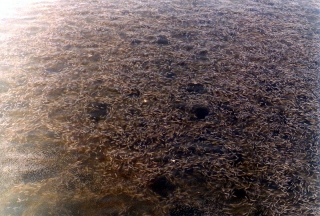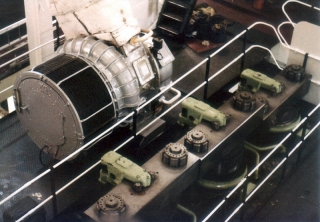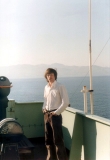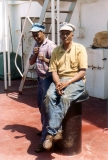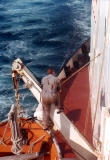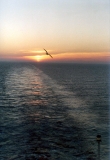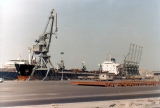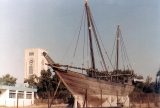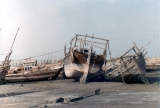MV Letchworth
A few days before Xmas 77 we joined the Letchworth in Dunkirk and sailed off into the sunset (literally) to pick up cargo in Antwerp. This was to be a glorious seven month trip, although in truth I think the Company had forgotten that Neil (the other engineering cadet) and I were onboard until we eventually wrote to remind them.
From Antwerp we crossed the North Atlantic to Providence though some of the worse seas I can remember (worse than rounding the cape), with spray smacking the side of the bridge wing and the ship rolling like a drunk.
This photo does not come close to doing it justice as I was far too seasick to think about taking photos until it calmed down.
After a fortnight in which I lost about a stone in weight I remember asking the second engineer to arrange a helicopter for me to be taken off !
Providence was followed by Baltimore where Neil and I took a Greyhound to Washington DC for the obligatory sight seeing. It stayed sunny while we crammed in as many tourist attractions as we could, but it was bitterly cold and people were ice skating on the reflecting pool in front of the Washington Monument.
We had quite a mixture of cargos, everything from paper to cotton but one of the most memorable was loose grain.
I’m not saying they spilt any while loading but I think something was attracting the fish !
As engineering cadets we were expected to work on all things mechanical and that included the main engine, which in the case of the Letchworth was a massive Doxford J type the size of a house. A heavy oil two-stroke opposed piston engine, each of its huge vertical cylinders contained two pistons which were forced apart during combustion.
It was so big you could climb along the crankshaft inside the engine casing, and during maintenance once the upper piston was hoisted out I stood on top of the lower piston inside a cylinder and inspected the lining while compressed air turned the engine very slowly moving the piston up and down!
After America we headed back across the Atlantic to the warmer waters of the Mediterranean, then spent two weeks anchored off Rejeka before docking. Yugoslavia was followed by Romania and a wonderful day ashore browsing the colourful local markets before deciding a delicate glass decanter and hand painted goblets would make the perfect gift for mum. How I managed to get them halfway around the world and through airport baggage handling without breaking them remains a mystery to this day.
Next it was south to Port Said for fuel then down through Suez and the Red Sea on our way to Kuwait. We managed to draw the attention of the authorities twice in one day in Kuwait, once for not wearing a shirt (they seemed very concerned about suburn!) and once for taking photos of some fantastic old wooden boats in what turned out to be the grounds of a college!
From Kuwait we made our way across the Indian Ocean to Durban in South Africa and a final chance for some serious tourism before heading home. As usual we couldn’t wait to get shore side to check out an exciting new port looking for souvenirs and places of interest to photograph.
In all innocence I took the first bus that came along and went into Durban – now you have to appreciate that this was thirty years ago and I had never even heard the word apartheid. I couldn’t understand the worried looks and glares I was attracting, how was I to know blacks and whites were not allowed to mix and had separate buses?
I’m no navigator but I think this was our route (I may have slept through a couple of stops) …
Dunkirk (France) – English Channel – Antwerp (Belgium) – English Channel – North Atlantic – Providence (Rhode Island) – Bridgeport (Connecticut) – Baltimore (Maryland) – North Atlantic – Strait of Gibraltar – Mediterranean – Adriatic Sea – Rejeka (Croatia) – Adriatic Sea – Aegean Sea – Sea of Marmara – Istanbul (Turkey) – Bosphorus Strait – Black Sea – Constanta (Romania) – Black Sea – Bosphorus Strait – Istanbul (Turkey) – Sea of Marmara – Aegean Sea – Sea of Crete – Port Said (Egypt) – Suez Canal – Gulf of Suez – Red Sea – Gulf of Aden – Arabian Sea – Gulf of Oman – Strait of Hormuz – Persian Gulf – Kuwait (Arab Emirates) – Persian Gulf – Strait of Hormuz – Arabian Sea – Indian Ocean – Durban (South Africa) – South Atlantic – North Atlantic – English Channel – Antwerp (Belgium).
